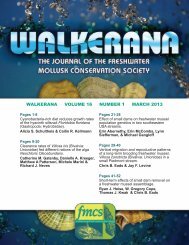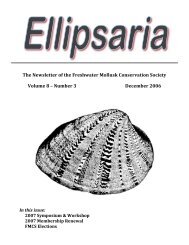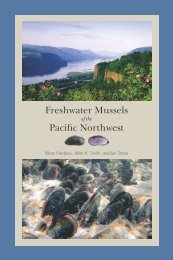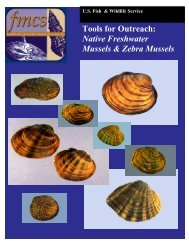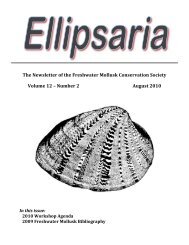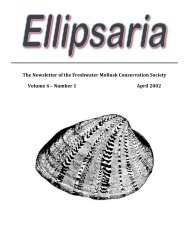August 2004 - FMCS-Freshwater Mollusk Conservation
August 2004 - FMCS-Freshwater Mollusk Conservation
August 2004 - FMCS-Freshwater Mollusk Conservation
You also want an ePaper? Increase the reach of your titles
YUMPU automatically turns print PDFs into web optimized ePapers that Google loves.
periods than today. At many places intensive farming with<br />
the help of ingenious irrigation methods have been<br />
discovered. Most of these farms have one thing in common:<br />
they were deserted towards the end of the Byzantine period<br />
or the beginning of the Early Islamic period (6 th -7 th Century<br />
C.E.). One such farm was situated near ‘En ‘Avrona in the<br />
Arava Valley, north of Elat. Samples taken from an<br />
irrigation pool, which stopped functioning during the Early<br />
Islamic period, contained numerous specimens of<br />
Melanoides tuberculatus (Müller, 1774), Melanopsis<br />
buccinoidea (Olivier, 1801) and what seems to be an<br />
undescribed species of Heleobia. Specimens belonging to<br />
Melanopsis were submitted for radiocarbon dating and this<br />
resulted in a C value of 6575+90 BP (BP=before present)<br />
(Segal & Carmi, 1996: 98), i.e. about 5000 years older than<br />
it was supposed to be.<br />
Near Tel Goded, in the Judean lowlands, an interesting water<br />
system which provided water to the ancient settlement of Bet<br />
Guvrin during historic times has been excavated (Sagiv et<br />
al., 1997). This water system consisted of a man-made pool<br />
and a stone-hewn canal running from Tel Goded to Bet<br />
Guvrin. At the bottom of the pool, more exactly in the<br />
south-eastern corner of it, a rich assortment of freshwater<br />
molluscs was discovered, showing that the pool was fed with<br />
running water year round (Mienis, in preparation). Today<br />
you will look in vain for a spring or streamlet on the map of<br />
that area. That part of the pool had been built during or after<br />
the reign of Constantius II (337-361 C.E.); a coin dating<br />
back to that period was found pressed into the plaster at the<br />
base of its inner wall. A batch of snails belonging to<br />
Melanopsis buccinoidea was also submitted for radiocarbon<br />
dating, which resulted in a C value of 5615+60 BP (Segal<br />
& Carmi, 1996: 91-92), i.e. about 4000 years too old.<br />
How can we explain these anomalies?<br />
According to Segal & Carmi (1996: 92) these anomalies are<br />
caused by the incorporation of water carbonate into the<br />
shells by the snails as seen from the C value. In my<br />
opinion it is much more likely that Melanopsis picks up old<br />
carbonate particles while scraping algae from the submerged<br />
limestone rocks and other objects in its aquatic environment.<br />
A part of this material is being incorporated in the shell and<br />
this results in a mixing of old and contemporary carbonates<br />
(i.e. from the time the snail actually lived) within the shell<br />
matrix. Since such a mixture is highly environmentally<br />
dependant and may vary from place to place, it is probably<br />
impossible to find a tool for calibrating the C values. At<br />
the Weizmann Institute they are now looking for a method to<br />
separate organic particles from freshwater shells and to<br />
restrict the radiocarbon dating process to these fractions in<br />
order to obtain more reliable dating results.<br />
References<br />
Sagiv, N., Zissu, B. & Amit, D., 1997. [A water system<br />
north of Bet Guvrin.] In Y. Eshel (Ed.): Studies of Judea<br />
and Samaria, 245-258. (in Hebrew)<br />
Segal, D. & Carmi, I., 1996. Rehovot radiocarbon date list<br />
V. Atiqot 29 (supplement):79-106.<br />
13<br />
Mussel Studies<br />
Steve Ahlstedt<br />
U. S. Geological Survey, Knoxville, TN 37921<br />
(865) 545-4140 x.17<br />
ahlstedt@usgs.gov<br />
Clinch and Powell Rivers, TN/VA<br />
Every five years since 1979, mussels in the Clinch and<br />
Powell Rivers are quantitatively evaluated (quadrate<br />
sampling). This has established long-term trend monitoring<br />
for mussel populations in both drainages. It was determined<br />
that only 12 sites would be evaluated in <strong>2004</strong> (6 each in both<br />
rivers). Sampling in the Powell River is completed. Mussel<br />
densities and species composition continue a downward<br />
trend. The Powell suffers from high concentrations of coal<br />
fines mined and released from settling lagoons in Virginia.<br />
Four of the six sites in the Clinch are finished and sites in<br />
Tennessee (3) show a continued upward trend in mussel<br />
densities and species composition. Many juvenile T & E<br />
species, especially E. capsaeformis and E. brevidens, were<br />
noted along with C. stegaria and P. plenum. Of concern is<br />
the amount of coal fines showing up in Tennessee from<br />
mining operations in Virginia. Black-water events from coal<br />
mining operations are a serious problem and unless it is<br />
stopped, the Clinch will look like the Powell.<br />
Powell River, TN/VA<br />
Gravid P. cyphyus and L. fasciola were collected from the<br />
Powell River for culture and propagation at Virginia’s Buller<br />
hatchery and Virginia Tech’s mussel culture facility. This is<br />
a joint effort between Virginia Department of Fish and<br />
Game, VPI, FWS, and USGS. Goals are to restore mussel<br />
populations in the Powell River.<br />
Cumberland Plateau – Upper Caney Fork, TN<br />
Survey efforts in the upper Caney Fork drainage found some<br />
new populations of Pleurobema gibberum and<br />
Venustachoncha sima. No P. fabula or L. diversa were<br />
found. Survey will continue this fall.<br />
Big South Fork Cumberland (TN), Clinch River<br />
(TN), Paint Rock River (AL), Mobile River Basin<br />
Continue assisting with the collection of gravid T & E<br />
mussel species for culture and propagation at Virginia<br />
Tech’s mussel culture facility and Tennessee Aquarium<br />
Research Institute’s mussel culture facility located in<br />
Cohutta, Georgia. Gravid E. capsaeformis, E. brevidens,<br />
E. walkeri, V. perpurpurea, T. cylindrellus, P. greenii, and<br />
L. altilus were found for culturing.<br />
Duck River Report and Juvenile Mussel Habitat<br />
Study<br />
Final report to The Nature Conservancy is just about<br />
completed. Will be starting a juvenile mussel habitat study<br />
related to increased flows in the Duck River. Increased<br />
minimum flows in the last 10 years from TVA’s Normandy



